Kohlrabi is a crunchy, delicious and versatile vegetable. I love it as a snack, simply steamed with a little salt and pepper, with potatoes and bechamel sauce, as a vegan curry or, of course, as fermented kohlrabi with spices.
The light green tubers are incredibly fresh and juicy, and, although it belongs to the cabbage family, kohlrabi is mild and also easily digested raw. It has a rather hard skin, so you should peel the tuber before eating it.
Kohlrabi is a zero waste vegetable
The leaves of kohlrabi are not only edible, but actually very healthy. They have twice the vitamin C content of the tuber, 100 times the carotene and 10 times the calcium and iron content. A good reason not to simply compost them, but to process them as well. Tasty, also healthy and with the dark green color it also brings a nice contrast to the food.
Kohlrabi is in season in Germany from May to November. And if you ferment it, you can enjoy it even longer.
Fermented Kohlrabi with spices from Sri Lanka
One of my favorite curries is green and rather mild. To simply ferment the ingredients instead of cooking them as a curry, came to me no sooner than just the other day. I had a lot of kohlrabi in the cta box, in fact, and planned fermented kohlrabi kakdugi kimchi alongside the curry when the thoughts crossed. The ferment basically works the same way the dish does, except you don't need a stove to cook it. Fermentation is not considered fireless cooking for nothing.
Ingredients
- 1-2 kohlrabi with greens
- 1 small white onion
- 1 tbsp dried curry leaves
- 1 fresh green chilli
- 2% salt
- 1 tsp green spice mix *
- 1 tsp fenugreek seeds
- 1 pinch of cinnamon
* For all those who do not have so many different spices in the house, I recommend Herbaria Organic Mild Wild Green as a ready-made spice mix. Also very good is the traditional, unroasted Thuna Paha, which you can make yourself from fennel seeds, cumin, coriander, cinnamon and curry leaves.




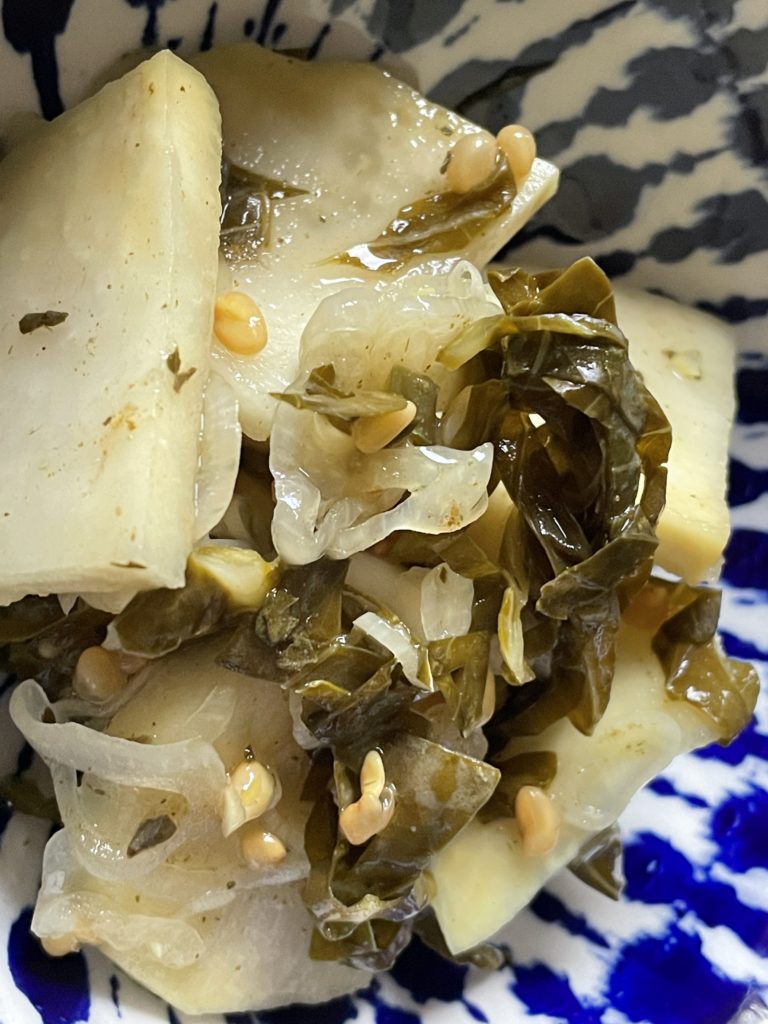
Preparation
Peel the kohlrabi, cut in half lengthwise and cut into 0.5 - 1 cm thick slices, cut the kohlrabi leaves into chiffonade. Then cut the onion and chili into fine rings. Mix, sprinkle with the salt and spices and leave to draw water.
Pour into a suitable fermentation vessel, such as a bail jar, and cover with a weight or other barrier. If not enough brine has formed to cover everything well, you can readjust with water.
Leave to ferment in a warm, dark place. Fermented kohlrabi tastes best to me after a short fermentation time, so after 1-2 weeks I put the container in the refrigerator to slow down the fermentation process. It keeps there for many months. You can, of course, just leave it in the cupboard or on the shelf. It will be a little more sour and a little softer than if you refrigerate it - but maybe that's what you like best. Try it out!
Knol Khol Curry
In Sri Lanka, kohlrabi is called knol khol, and I make this curry fresh from the same ingredients as the ferment. You might want to give it a try, it's really very tasty. Besides, you only have to shop and chop once if you make the ferment and the hot dish at the same time. I found the recipe on the blog Food Corner by Amila Gamage Wickramarachchi and changed it slightly over the years. You will find many more delicious dishes from Sri Lanka on the blog, it's worth the visit!
Ingredients
- 2-3 kohlrabi with greens
- 1 small white onion
- 1 tbsp dried curry leaves
- 1 fresh green chilli
- 1 tsp green spice mix *
- salt
- 1 tsp fenugreek seeds
- 1 Ceylon cinnamon stick
- 1 small pack of coconut cream (100 gr.)
- 1 small pack of Aroy-D coconut milk (150 ml)
* For all those who do not have so many different spices in the house, I recommend Herbaria Organic Mild Wild Green as a ready-made spice mix. Also very good is the traditional, unroasted Thuna Paha, which you can make yourself from fennel seeds, cumin, coriander, cinnamon and curry leaves.
Preparation
Peel kohlrabi and cut into bite-sized pieces. Cut kohlrabi leaves into chiffonade. Finely chop onion and powder curry leaves. You can also use fresh curry leaves, then strip from the stem.
Put all the ingredients except the coconut milk and cream in a pot and sauté briefly. Then add a little water and steam for a few minutes with the lid closed. Add the coconut milk and let it boil down for about 10 minutes, until the kohlrabi is almost cooked. Then add the coconut cream.
Season with salt and serve with white rice.
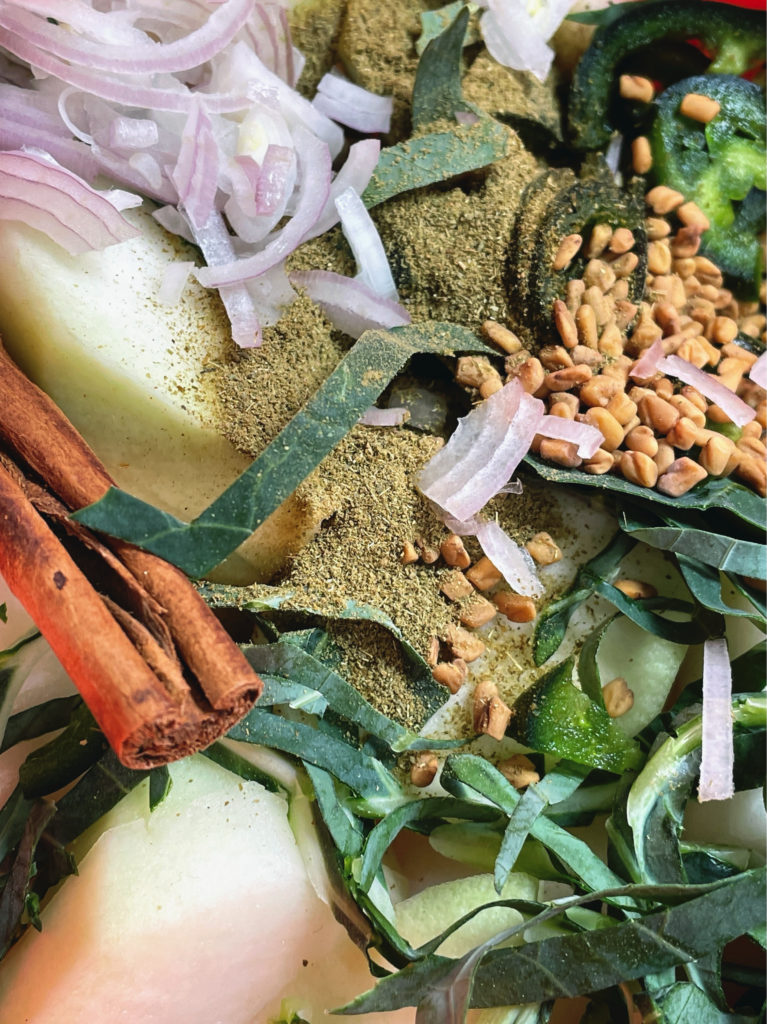
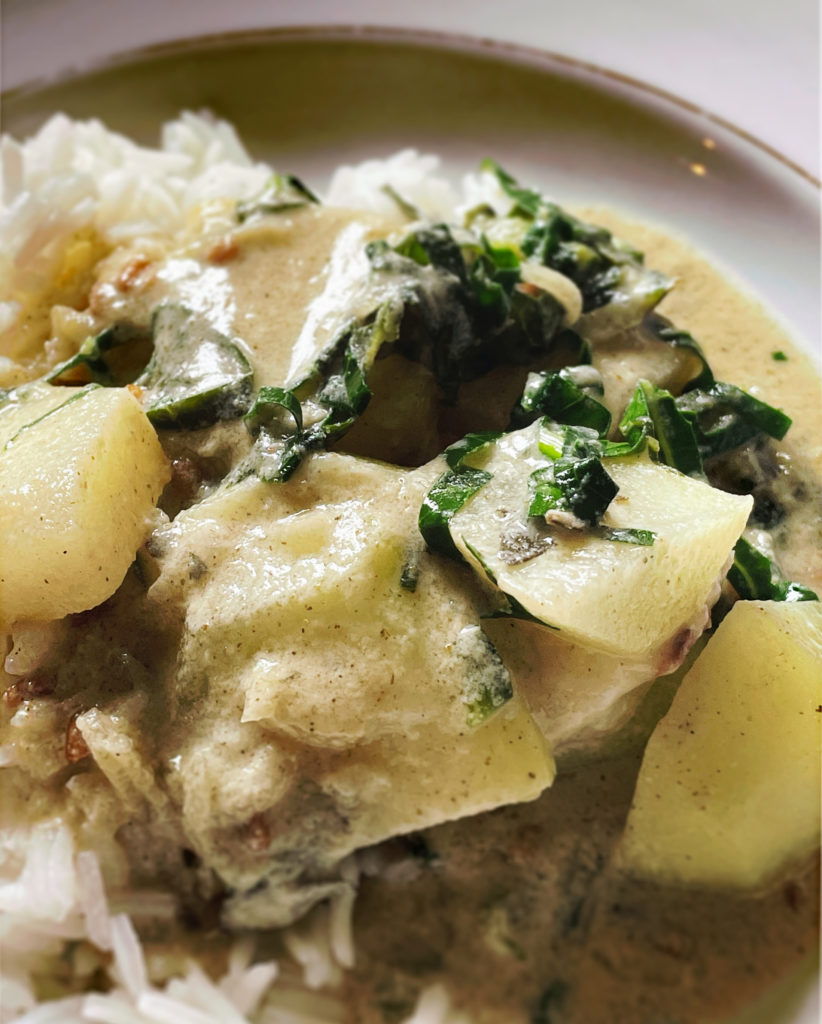
Hot fermented kohlrabi with spices and carrots
Since the green kohlrabi ferment with spices tastes so great, I tried other combinations with vegetables and spices. Kohlrabi tastes really delicious with carrots, because both develop a similar mouthfeel, which, however, develops differently to the exact extent that the gustatory remains exciting.
Kohlrabi combined with carrots and a yellow-orange spice blend tastes really delicious, plus the ferment looks great in orange! If you like fermented kohlrabi and the flavors of Indian cuisine, you should definitely try it.
Ingredients
- 1-2 kohlrabi *
- 2-4 carrots
- 1 small red onion
- 2% salt
- 1 tsp spice mix **
- 1 tbsp gochugaru or other chili flakes
* because of the sunny color I do without the kohlrabi leaves in this ferment and use them elsewhere. Of course, they would still taste fine.
** in combination with the sweet carrots I love the fruity Herbaria Organic Calypso Tropical spice blend. If you make your own spice blends, turmeric, ginger and galangal are definitely part of the mix.

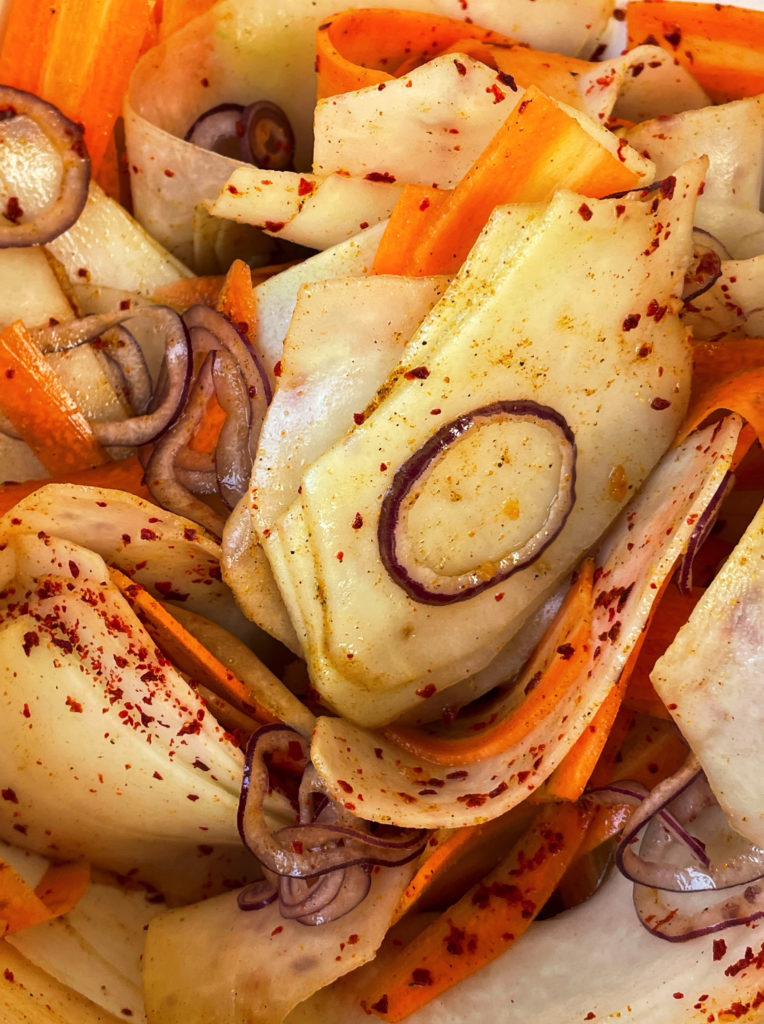

Preparation
Peel the kohlrabi and carrots and cut into bite-sized slices. Cut the onion into fine rings. Then mix, sprinkle with the salt and spices and leave to draw water.
Fill into a suitable fermentation vessel, such as a bail jar, and cover with a weight or other barrier. If not enough brine has formed to cover everything well, you can readjust with water.
Leave to ferment in a warm, dark place. Depending on how thick you cut the pieces, the fermentation time will change. Thinly sliced kohlrabi quickly becomes soft, so a week can already be too long. I always adjust the thickness of the vegetable pieces to the planned consumption. After 14 days at the latest, I put this ferment into cold storage. This does not have to be a refrigerator, a cold cellar is also suitable.


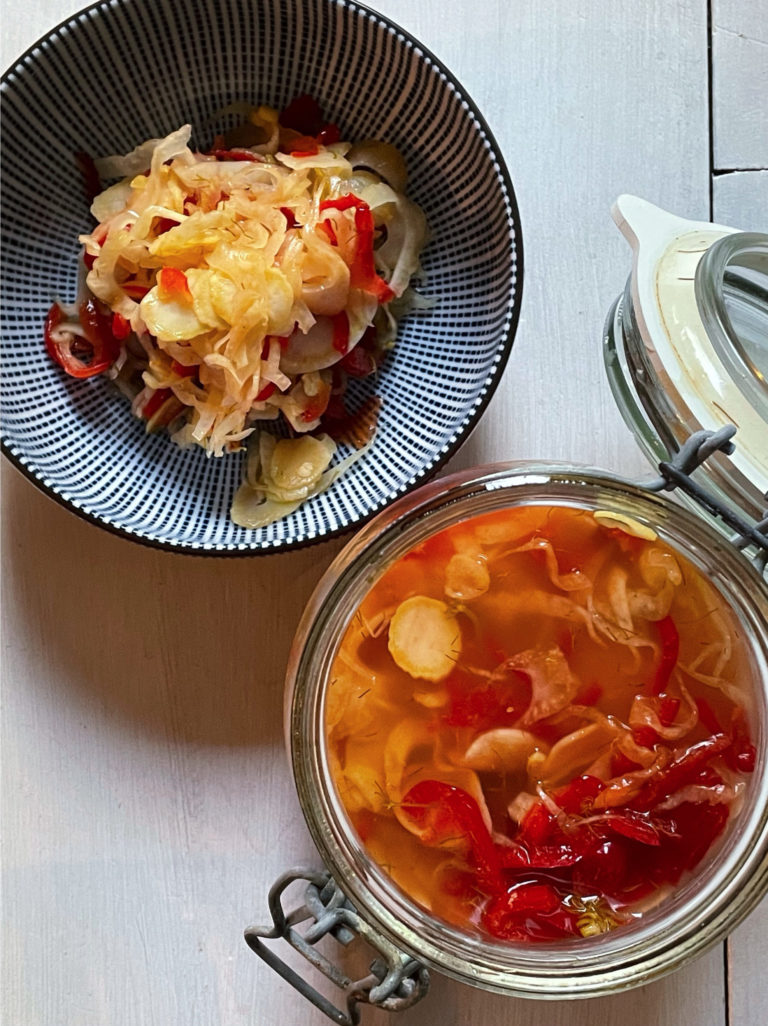

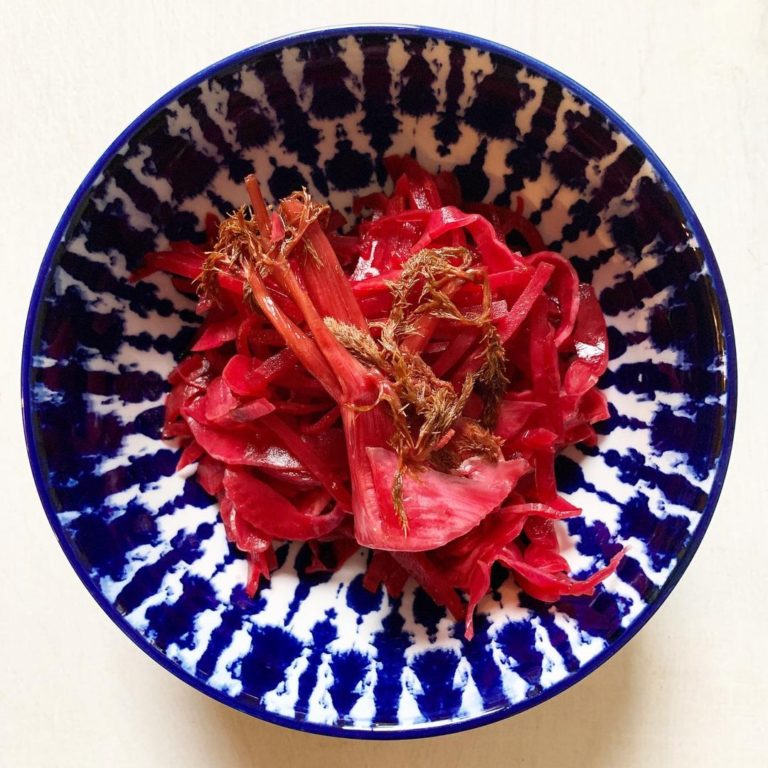
Hey liebe Katsu, was meinst du denn genau mit „2 Prozent Salt“? Hab mega Lust, deine Rezepte auszuprobieren. Danke für deinen tollen Blog! Liebe Grüße, Sandra
Hej Sandra,
das bedeutet, dass Du vom Gesamtgewicht 2% errechnest und diese Zahl dann die Grammzahl an Salz ist, die benutzt wird.
Viel Spaß beim Ausprobieren!
Katsu
Hi Katsu,
Ich würde mir mal ein Kürbis Rezept von dir wünschen. Ich hab jetzt einfach mal Kürbis in 3% iger Salzlake mit ner Knobi Zehe, ein paar getrockneten Bird Eye Chilis und einer Scheibe Ingwer angesetzt. Mal schauen. Wie lange würdest du es bei Zimmertemperatur stehen lassen ? 14 Tage ?
Viele Grüße
Michi
Hej Michaela,
für Kürbis habe ich tatsächlich erst jetzt, nach so vielen Jahren, zwei gute Rezepte. Eines aus Korea (was nicht sehr erstaunlich ist, erstaunlich nur, dass ich es so lange nicht kannte) und ein selbst erdachtes. Wenn ich beide mehr als 3 mal erfolgreich fermentiert habe gibt es die Rezepte auch auf der Seite.
Dein Ferment würde ich nach 10 Tagen das erste Mal probieren. Du hast den Kürbis in dünne Streifen geschnitten?
Gutes Gelingen,
Katsu
Hi Katsu,
Ich habe den Kürbis in 2×2 cm große Würfel geschnitten
Ich wünsche dir, dass es gelingt und schmeckt!
Hi Katsu,
Würdest du den Kürbis, obwohl ich ihn in große Stücke geschnitten habe, trotzdem nach 10 Tagen probieren oder würdest Du länger warten ? Ich freue mich schon auf deine Kürbis Rezepte 😊
LG
Hej Michi, probier jetzt und wenn es dir noch nicht schmeckt, lass das Ferment im Kühlschrank weiter reifen, bis du es magst.
Hallo liebe Katsu,
vielen Dank für das geniale Sri-Lanka-Kohlrabi-Rezept! Da ich bei uns von Herbaria kein „Mild Wild Green“ bekommen kann, habe ich stattdessen „Grüner Kakadu“ genommen – es schmeckt genial gut und ich setze heute schon die nächste Charche an!
Liebe Grüße aus dem Süden!
Hej Ankecaro,
das freut mich, dass es Dir so gut schmeckt! Danke für den Tip mit der Gewürzmischung, das ist bestimmt auch für andere interessant.
Guten Appetit,
Katsu
Hallo Katsu,
Vielen Dank für Deine wunderbare Website, anhand derer ich mich grad in die Geheimnisse der Fermentation einarbeite.
Ich habe letztes Wochenende mit den ersten Ansätzen gestartet und dabei gemerkt, dass ich noch eine Detailfrage habe.
Du schreibst in mehreren Rezepten „Sollte nicht genug Lake entstanden sein, um alles gut zu bedecken, kann mit Wasser nachjustiert werden“ – ist damit normales Wasser gemeint, oder Salzwasser in der jeweiligen Konzentration des Rezeptes?
Fände Salzwasser logisch, da ich andernfalls ja die Salzkonzentration der Flüssigkeit senke und das dann evt. zu niedrig wird, um unerwünschtes Bakterienwachstum zu hemmen. Aber da ich keine entsprechende Info finden konnte, frag ich doch lieber mal nach, bevor ich beim nächsten Mal alles versalze. 😉
P.S. Den schnellen Lauchsalat habe ich heute schon probiert und der ist super würzig und schmeckt mega lecker!
Hej Sandra,
und eine weitere mit dem Fermentier-Fieber angesteckt, wie schön <3
Ich meine tatsächlich einfach nur Wasser, wenn ich Wasser schreibe. Da es sich meistens um eher wenig Flüssigkeit handelt, mit der nachjustiert wird, hat das einen 5 vernachlässigenden Einfluss auf die Salinität. Du kannst natürlich auch Salzlake herstellen - bei 50-60 ml nimmst Du dann am besten eine Feinwaage, oder 1 Prise, um auf 2% zu kommen.
Gutes Gelingen!
Katsu
Oder einen Schluck aus den Ansätzen verschiedener Salinität, die ich hier grad aus diversen anderen Rezepten rumstehen habe… 😀
Vielen Dank jedenfalls für die schnelle Antwort, dann ist ja alles halb so wild. Nur bei dem Kohlrabi oben musste ich doch einiges an Wasser zugeben, da irgendwie so gar keine Lake entstehen wollte.
Hab schon die nächsten Rezepte probieren können und gerade eben ein Ananas-Kkakdugi angesetzt. 😀
Danke nochmal! <3
Hallo Katsu, ich bin ganz neu im Fermentieren und habe als Erstversuch zwei Gläser mit Kohlrabi angesetzt. Ich habe die Scheiben aber übereinander gestapelt, und nicht so locker „reingelegt“, wie es bei dir der Fall ist. Daran habe ich beim Befüllen gar nicht drauf geachtet. Nun sehe ich heute nach zwei Tagen, dass sich an einigen Stellen Luftblasen zwischen den einzelnen Schichten gebildet haben, obwohl die Masse aber an sich komplett von Flüssigkeit bedeckt ist. Meine Frage: kann ich das noch retten? Ich habe das Glas schon etwas hin-und-her bewegt, aber die Blasen steigen nicht nach oben. Ich habe das ganze wohl zu fest „gepackt“.
Ich hoffe auf dein Expertenwissen und freue mich auf deinen Ratschlag 🙂
Liebe Grüße aus dem Schwarzwald, Maren
Hej Maren,
nach einigen Tagen sollte das Milieu im Glas schon anaerob sein, so dass ein paar gefangene Bläschen nichts ausmachen sollten. Bei den Bläschen handelt es sich ja auch nicht um Sauerstoff, sondern im Femrentationsprozess entstandenes Kohlendioxid. Ich gebe also vorsichtig Entwarnung – beobachten solltest du es natürlich trotzdem.
Toi toi toi!
Katsu